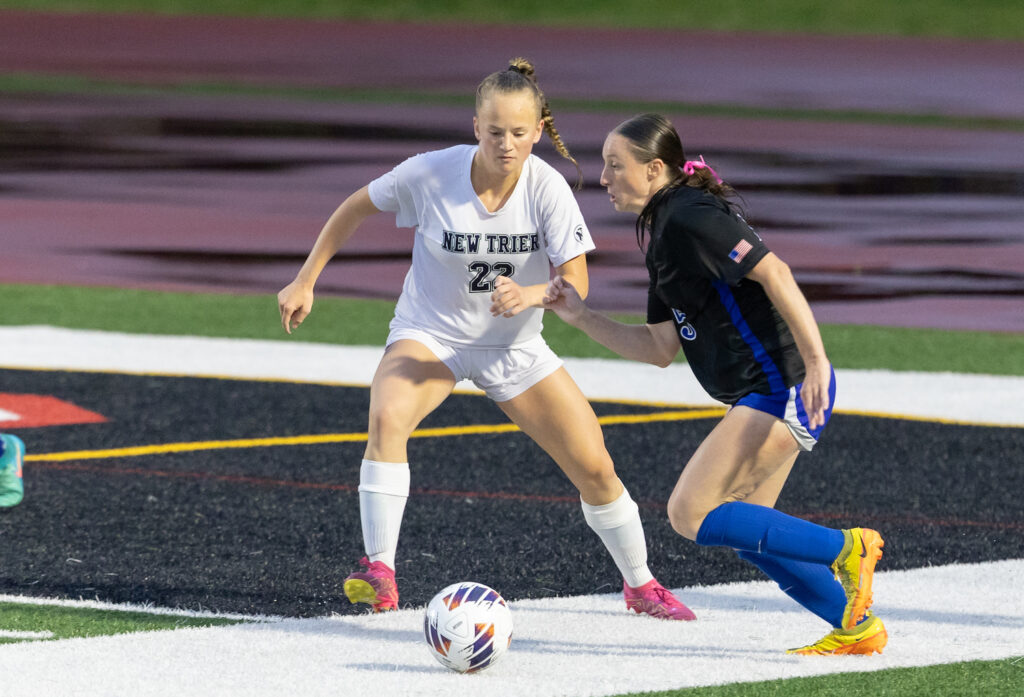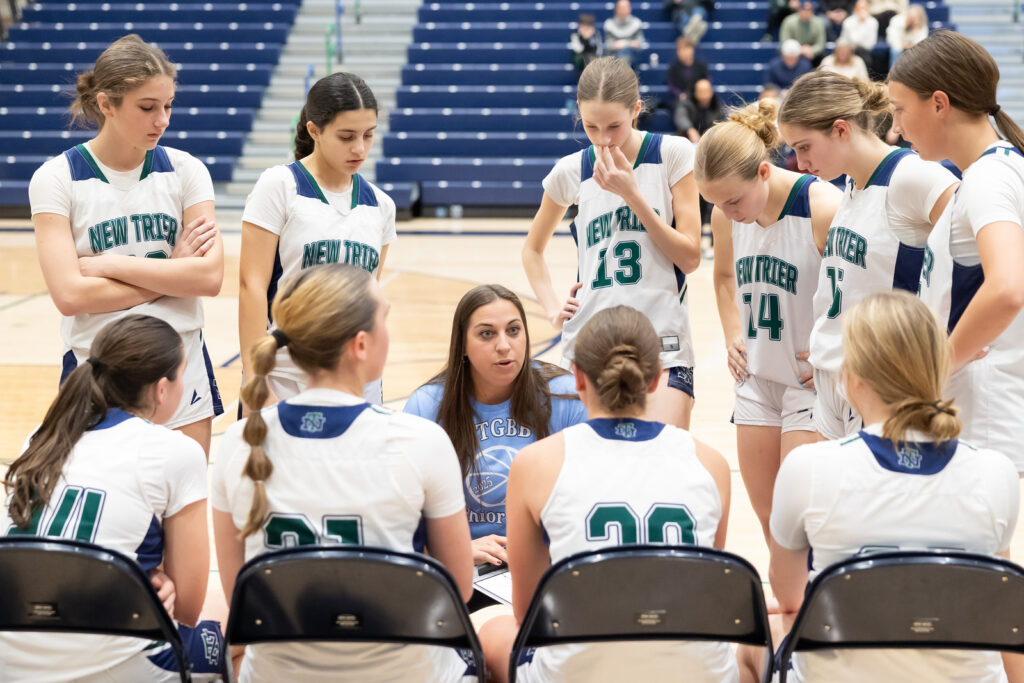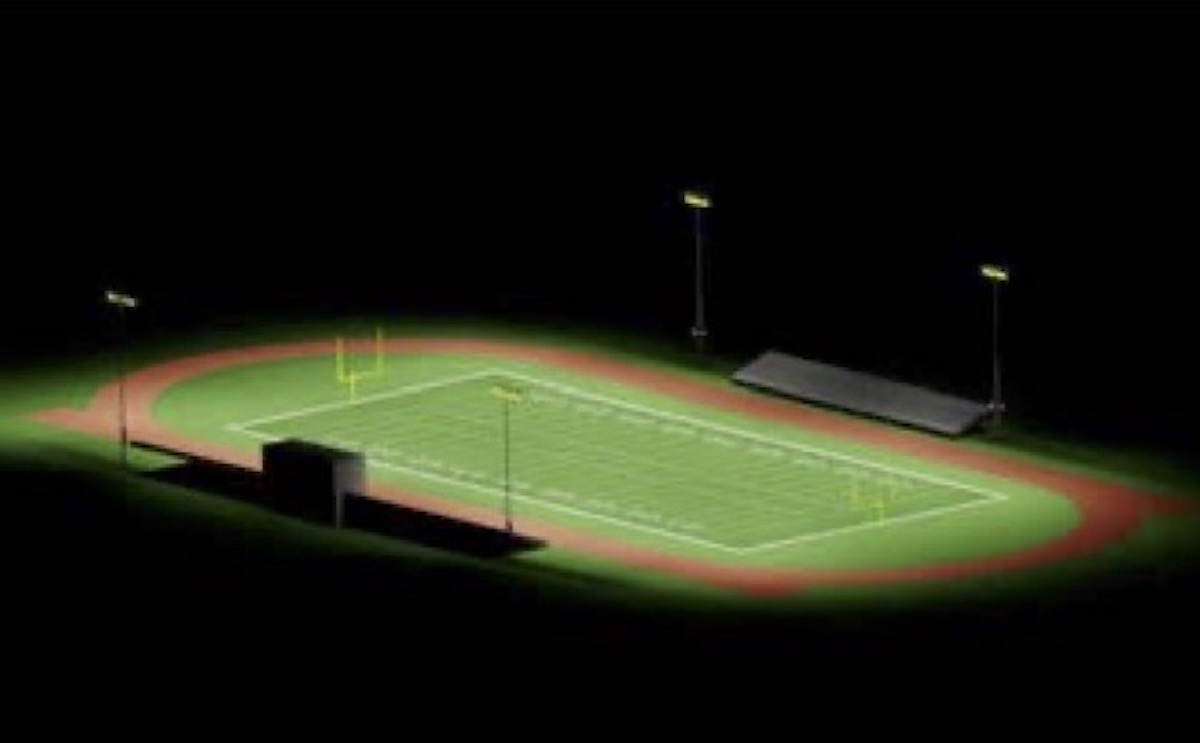
Wilmette trustees see the light for Loyola Academy
Wilmette high school can add permanent lighting to stadium under a number of conditions
In the waning moments of a five-hour meeting that included dozens of public comments, extended periods of deliberation and nearly 100 locals filling council chambers, Wilmette trustees decided to let there be light.
During its meeting on Tuesday, Nov. 14, Wilmette’s Village Board approved with a 6-1 vote a request from Loyola Academy that will allow the private high school to install and operate permanent outdoor lights at its athletic stadium on the northeast corner of Lake and Laramie avenues.
Loyola’s proposal will now advance to another appearance in front of the Village Board on Dec. 12, when trustees will finalize and presumably approve a lengthy list of conditions attached to the permit to install the lights.
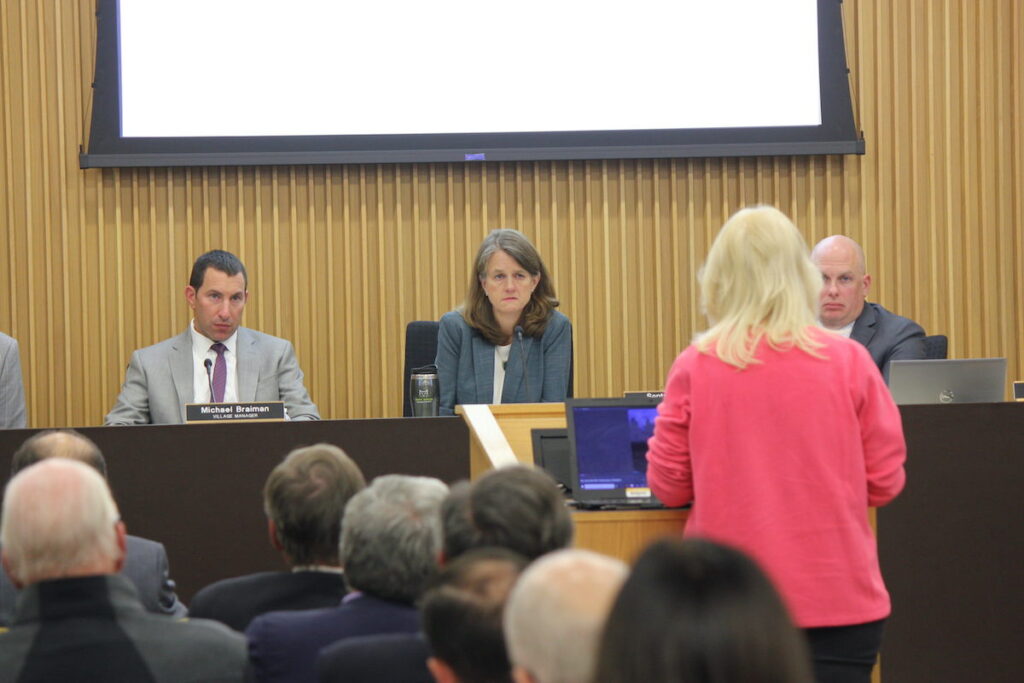
As previously reported by The Record, the anchor of the school’s proposal is its plans to install four 80-foot light poles, two on each side of Hoerster Field, at Sachs Stadium on its Wilmette campus.
Before Loyola’s request made its way to trustees, Wilmette’s Zoning Board of Appeals considered the proposal over eight hours of discussion spread across two separate meetings, ultimately giving the request a negative recommendation with a 3-2 vote.
The school scaled down its request following the negative outcome from the zoning board. Its updated proposal reduced the maximum of Friday night athletic contests from five to four. It also included a provision that it will limit light use to three Friday night football games for the first and second seasons after the lights are installed, according to village documents.
Additionally, Loyola offered an earlier cut-off time for the lights (shifting from 10:30 to 10 p.m.), committed to having at least four off-duty police officers present at each varsity football game played on Friday night during the first season, and reduced the number of nonfootball athletic contests from 25 to 20.
In total, the approved plan grants Loyola the ability to use the lights 54 nights per year, which is fewer than the 60 nights the school proposed when the zoning board considered the request.
Representatives from the school stated at the Village Board meeting that Loyola originally had targeted 183 nights of use when it first considered bringing the project forward late last year.
Loyola’s updated plan, because of the zoning board’s unfavorable recommendation, required a supermajority approval from trustees, meaning at least five board members needed to cast their support for the project.
Trustees greenlighted the proposal during the Nov. 14 meeting via a 6-1 vote. Board member Gina Kennedy was the dissenter, citing myriad concerns, such as safety, traffic control, parking, enforcement of the proposed restrictions included in the plan, and the impact on the surrounding neighborhood.
“Loyola has done a very sensitive job of carving back from their first iteration of this project, and I appreciate those efforts and I think that was done in good faith and it is a serious concession,” Kennedy said. “But despite that, it just seems to be that the neighborhood has borne a lot and is at its tipping point. I don’t want to be responsible for making it worse.”
Kathy Dodd, who is the chair of the board’s land use subcommittee, followed Kennedy’s comments by saying she sees the school’s proposal “slightly differently.”
“In order for us to continue to be a thriving community, we have to support some change,” Dodd said. “That is why our community is where it is and so I would struggle if we can’t find a way to allow Loyola to make some of these changes in an effort to provide an improved experience for their students.”
The remaining members of the board expressed support while reiterating their desire to clearly outline the final conditions attached to the ordinance before their final approval.
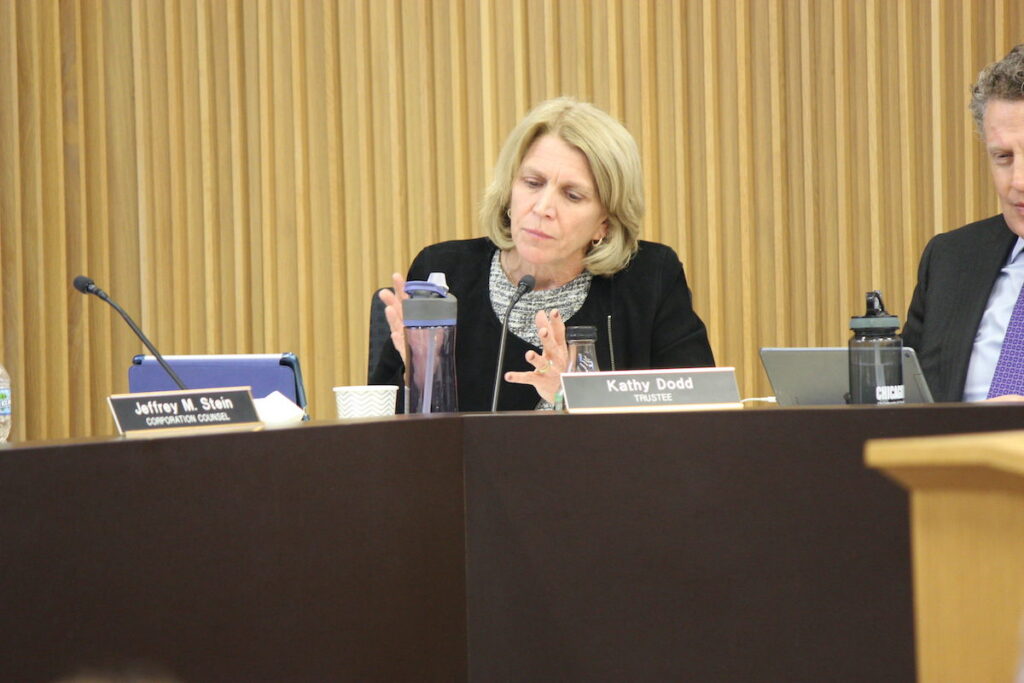
Trustees Justin Sheperd, Stephen Leonard and Gerry Smith and Wilmette Village President Senta Plunkett all called the school’s request “reasonable” while explaining their support near the meeting’s conclusion. Leonard said he believed it was an “opportunity for compromise.”
Trustee Kate Gjaja admitted she has “gone back and forth” on Loyola’s proposal “quite a bit” and noted that she felt “it’s a very close call.” She added that she hopes Loyola is “hearing that the neighborhood is really angry.”
But Gjaja indicated a key reason for her support was the ways in which she believes Loyola helps Wilmette be a welcoming and inclusive community.
“I think one of the great things about Loyola is that it does bring people to this community from over 100 zip codes,” she said.
“I am incredibly committed to this being a welcoming and inclusive community,” she added, noting that she felt troubled by some of the rhetoric from neighbors that focused on Wilmette needing to be careful about nonresidents coming into the community.
“We either commit to being a welcome, inclusive community or we don’t — and I believe we should,” Gjaja said. “And for me, what that means is we have to be willing to step out of our comfort zone of seeing the same people we see every day, we have to open our facilities, we have to open our beaches, our parks and our football fields. We have to do that in order to get to where I believe this community wants to be.”
After the board’s comments, Wilmette Village Manager Mike Braiman outlined a majority of the conditions that will be up for approval on the Dec. 12 agenda. The list from Braiman included, but is not limited to:
• No concerts or no third-party usage allowed; the lights are only to be used for athletic events featuring Loyola Academy athletes.
• Wilmette’s police chief will determine public safety needs and staffing requirements. Loyola will be required to reimburse for all that staffing.
• Any public address system would have to include a sound governor to limit noise levels.
• Loyola should annually submit a parking plan to the village prior to the start of the football season, identifying the remote parking lots and which games will have shuttle buses.
• Traffic plans should be reviewed as needed by Loyola staff and village staff.
• Violation provisions will be included in the ordinance. If Loyola violates any of the conditions of the ordinance, the school would be issued a substantial fine and the village manager has the ability to amend or revoke the special use.
• The lights will have an auto shut-off feature
• Loyola will provide a community liaison who could be contacted on game days to address neighbors’ problems in real time.
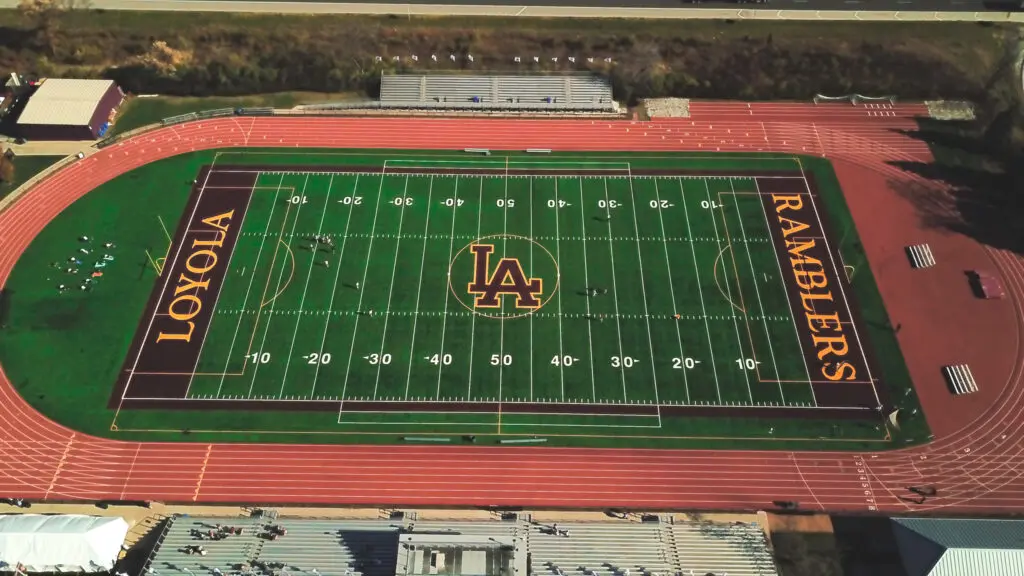
Public comment: ‘If the door is opened … it will never be shut’
Twenty-eight locals spoke during the public comment portion of the meeting, the majority of whom continued to express their sharp opposition to Loyola’s plans.
Matthew Hirschfeld, who lives on Laramie Avenue, urged the board “to be on the side of public safety.”
“Anyone who lives within proximity of the school like myself knows how overwhelmed the intersection of Lake and Laramie can be on school days,” he said. “Now, imagine trying to replicate that traffic at night when visibility is low with cars driving in and out of dark, crowded residential streets looking for parking.”
Lisa Crowe told the board that nearby residents have “weathered many changes in the neighborhood but not all changes represent progress and fairness.”
Crowe also echoed a main concern of many commenters who spoke at the meeting, saying that Loyola will only return to the board in the future to ask for increased light usage in the coming years.
“This campus is too small and too close to our homes to support these increased activities,” she said, later adding that “if the door is opened to nighttime games and events, it will never be shut.”
Earlier in the meeting during Loyola’s presentation, Marty Jennings, the school’s advancement chief of staff, told the board that Loyola will not return to ask for an increase to the proposal presented on Nov. 14 for at least the next five years.
Loyola Academy President Rev. Gregory J. Ostdiek also told the board that the school will not return to request additional light usage for as long as he remains president.
Mary Gaspar, a resident of nearby Forest Avenue, argued that “no amount of sound and traffic experts and lawyers can sufficiently suppress the real lived experience of us neighbors.”
“This is our home,” she said. “We have young kids. We have elderly neighbors. We operate several businesses and work on weekends. People need their rest. We need peace and quiet. These are needs and not wants. A lighted, Friday night game is a want, especially when you already have an extremely successful and thriving athletic department.”
Erin Keating, a Wilmette resident and member of Loyola Academy’s girls lacrosse and field hockey teams, spoke in support of the proposal, saying that installing lights at the school will “impact future generations.”
“As a female athlete, the addition of lights would give women’s sports at Loyola the opportunity to play big games under the lights in front of our classmates on our main campus,” Keating said.
“As a member of the girls lacrosse team at Loyola, it is unbelievable to think that even after winning 15 state championships, we have never been able to play a night game in our stadium or host state playoffs, despite our numerous number 1 seeds over the years,” she added.
Loyola wants ‘the same opportunities’
Loyola officials reiterated their reasoning for the school’s desire to add lights to its on-campus stadium during the Nov. 14 meeting.
As previously reported by The Record, the school’s proposal stems from an increase in participation in athletics and the need to extend the field usage in the stadium, according to Genevieve Atwood, Loyola Academy’s vice president for athletics and fitness.
Atwood has previously told officials that Loyola’s athletics facilities cannot currently accommodate all of the school’s teams, which she said leads to the Ramblers’ programs having to go “offsite to outdoor and indoor fields, causing many challenges for both our athletes and our coaches and our families.”
“We are requesting the installation of lights so that the Loyola Academy community may enjoy the same opportunities that local public and Catholic schools across the state have,” she told the Village Board.
Atwood later added that she believes the school has collaborated with Loyola’s neighbors.
“We have listened to the concerns of our neighbors and tried to minimize the impact while also supporting the needs of our athletic programs,” she said.
The Record is a nonprofit, nonpartisan community newsroom that relies on reader support to fuel its independent local journalism.
Subscribe to The Record to fund responsible news coverage for your community.
Already a subscriber? You can make a tax-deductible donation at any time.

Martin Carlino
Martin Carlino is a co-founder and the senior editor who assigns and edits The Record stories, while also bylining articles every week. Martin is an experienced and award-winning education reporter who was the editor of The Northbrook Tower.

